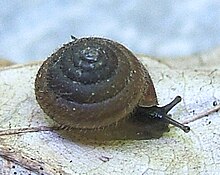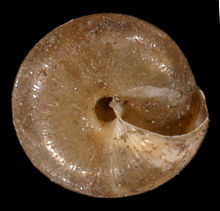Single-toothed hair snail
| Single-toothed hair snail | ||||||||||||
|---|---|---|---|---|---|---|---|---|---|---|---|---|

Single-toothed hair snail ( Trochulus unidentatus ) |
||||||||||||
| Systematics | ||||||||||||
|
||||||||||||
| Scientific name | ||||||||||||
| Trochulus unidentatus | ||||||||||||
| ( Draparnaud , 1805) |
The single-toothed hair snail ( Trochulus unidentatus , Syn . : Petasina unidentata , Trichia unidentata ) is a species of snail of the family of leaf snails (Hygromiidae) from the order of land snails (Stylommatophora).
features
The frustoconical housing measures 3.4 to 6.6 mm in height and 5.1 to 9.5 mm in width (3.5 to 6 × 5 to 9 mm). The index case width to height is 0.54 to 0.82. The outer line of the thread is slightly convex, while the underside is flattened. There are five to seven tightly twisted and well rounded whorls on the periphery. These are separated from each other by a shallow seam. The navel is very narrow; the diameter of the navel is 0.2-0.8 mm. The ratio of the navel width to the housing width is 0.03 to 0.11. The mouth is elliptical in cross-section and somewhat flattened at the lower edge. The mouth height measures 1.7 to 3.2 mm, the mouth width 3.0 to 5.2 mm. The mouth edge tapers off sharply and is simple at the top, curved outwards at the base and increasingly towards the spindle area. It can easily protrude all the way above the navel. A whitish or slightly pink lip is formed on the inside at the edge of the mouth. A strong, whitish tooth sits roughly in the middle of the base. The housing parameters vary from population to population.
The thin-walled housing is horn-colored, yellowish to reddish brown in color and opaque. Albinotic housings have also been found. Occasionally a light band is formed on the last turn. The surface of the case shows fine growth stripes at irregular intervals. There are numerous, evenly distributed, about 0.5 mm long and curved hairs on the surface. In adult animals, the hair has mostly already fallen out and only the attachment points of the hairs are visible.
In the male tract of the hermaphroditic genital apparatus, the short, slightly wound vas deferens enter the epiphallus at a right angle. The flagellum reaches about 2/3 the length of the epiphallus. The cylindrical epiphallus is slightly longer than the penis, which can also be curved distally. The penile retractor muscle starts in the transition area between the epiphallus and penis. The cylindrical vagina is comparatively long. In the middle are four arrow sacks, one outer and one inner arrow sack. The inner pair reaches the attachment of the glandulae mucosae. The four pairs of glandulae mucosae, approx. 2 mm long, are located more proximally on the vagina. The stem of the spermathek is slightly twisted, the hammer-shaped spermathek lies against the egg ladder and does not reach the albumin gland.
Similar species
The very similar toothless hair snail ( Trochulus edentulus ) has, as the trivial and scientific name expresses, no mouth reinforcement . The bidentate leaf snail ( Perforatella bidentata ), on the other hand, has two teeth in its mouth.
Geographical distribution and habitat
The distribution area of the species extends from northern Italy and eastern Switzerland via Germany, the Czech Republic, Austria to southern Poland, Slovakia and Hungary. In Germany the species occurs in the Alps and in the foothills of the Alps, rarely also in Saxony, Rhineland-Palatinate and in a few other low mountain range locations.
The species lives in moist to moderately dry mountain forests up to above the tree line, usually between 500 and 1500 m above sea level, in Switzerland also up to 2300 m. It prefers stony and rocky locations on calcareous subsoil, and can be found in leaf litter, under dead wood and in rock rubble, but also rarely in the tall herbaceous area. The housings become smaller on average above 1000 m.
Taxonomy
The single-toothed hair snail can be found in the more recent literature and on most websites under the scientific name Trichia unidentata or Petasina unidentata . Schileyko treats Petasina as a subgenus of Trochulus . The genus name Trichia Hartmann, 1840 is preoccupied by Trichia de Haan, 1839 and also a younger synonym of Trochulus Chemnitz, 1786. An application to the International Commission for Zoological Nomenclature for the preservation of the genus name Trichia Hartmann, 1840 failed. Petasina Beck, 1847 a junior synonym of Trochulus Chemnitz, 1786. According to the taxonomic revision and phylogenetic analysis of the genus Trochulus by MaĹ,gorzata Proćków both come so far to the genus Petasina Beck, 1837 types provided, Petasina unidentata and Petasina edentula between the species of the genus Trochulus to lie. Petasina unidentata is the sister species of Trochulus bielzi and Petasina edentula is the sister species of Trochulus bakowskii . Both pairs of sister species also belong to completely different branches of the Trochulus family tree. The genus Petasina is therefore polyphyletic and taxonomically not tenable even after being restricted to the type species. The genus Petasina Beck, 1847 was also divided by many authors into two or three subgenus: Petasina (Petasina) (the nominate subgenus ), Petasina (Edentiella) Polinski, 1929 and Petasina (Filicinella) Polinski, 1929. These taxa are polyphyletic and come for the subdivision of the large genus Trochulus out of question. These new results on the phylogeny of the genus Trochulus seem to have not been taken into account in some secondary publications , since the species can still be found there under the genus name Petasina (e.g. Wiese). The name Petasina Beck, 1847, is also extremely problematic, as it is not clear whether it is even a name available according to the international rules of zoological nomenclature (see F. Welter-Schultes in AnimalBase).
The Arttaxon unidentata was set up in 1805 by Jacques Philippe Raymond Draparnaud as Helix unidentata . It is a younger homonym of Helix unidentata Holten, 1802 (currently Stylodonta unidentata (Holten, 1802)), a species of snail from the Seychelles. A more recent synonym of Helix unidentata Draparnaud, 1805, is Helix cobresiana Alten, 1812. The taxon was known under this species name until the 1930s, until Ehrmann (1933) took up the Draparnaud species name. He was followed by all later authors who apparently did not know the homonymy to Helix unidentata Holten, 1802. According to Art. 23.9.5 of the International Rules for Zoological Nomenclature, the Commission can be called in to include the younger homonym on the official list of valid names if both species were housed in different genera after 1899. But this is not the case here. The first work, in the Helix unidentata Holten, 1802 in a different genus i. e. Stylodonta was transferred, dated from 1909. Also Helix unidentata Draparnaud, 1805 was placed in the genus Helix by 1906 . The species name unidentata can very probably no longer be used for this species (see Welter-Schultes and other authors cited there). As a valid substitute name, Helix cobresiana Alten, 1812, would again come into question.
Previous authors separated up to six subspecies within the taxon Trochulus unidentatus (or Petasina unidentata ): Petasina (Petasina) unidentata alpestris (Clessin, 1878), Petasina (Petasina) unidentata bohemica (Lozek, 1948), Petasina (Petasina) unidentata carpatica (Polinski, 1929), Petasina (Petasina) unidentata norica (Polinski, 1929), Petasina (Petasina) unidentata subalpestris (Polinski, 1929) and Petasina (Petasina) unidentata unidentata (Draparnaud, 1805). Małgorzata Proćków found in her revision of the genus Trochulus that the housing parameters of the alleged subspecies overlap with other populations. She could not find any characteristics that would make the alleged subspecies unequivocally distinguishable and synonymized the subspecies with the nominate subspecies again.
According to Georg Kierdorf-Traut, the subspecies alpestris occurs in South Tyrol from 1800 to 2200 m above sea level, while the nominate subspecies occurs up to around 1800/1900 m. The alpestris case is slightly smaller with a flatter thread. The last turn is clearly keeled blunt. The mouth, however, is less flattened than in the nominate subspecies.
Danger
The species is classified as endangered in Germany according to the Red List. In terms of the distribution area as a whole, the species is not endangered according to the IUCN . Austria
supporting documents
literature
- Klaus Bogon: Land snails biology, ecology, biotope protection. Natur Verlag, Augsburg 1990, ISBN 3-89440-002-1 , p. 348f.
- Rosina Fechter, Gerhard Falkner: Mollusks. (= Steinbach's nature guide. 10). Mosaik-Verlag, Munich 1990, ISBN 3-570-03414-3 , p. 206.
- Michael P. Kerney, RAD Cameron, Jürgen H. Jungbluth: The land snails of Northern and Central Europe. Paul Parey, Hamburg / Berlin 1983, ISBN 3-490-17918-8 , p. 266.
Individual evidence
- ↑ a b c d Małgorzata Proćków: The genus Trochulus Chemnitz, 1786 (Gastropoda: Pulmonata: Hygromiidae) - a taxonomic revision. In: Folia Malacologica. 17 (3), Warsaw 2009, pp. 101–176. doi: 10.2478 / v10125-009-0013-0
- ↑ Francisco W. Welter-Schultes: European non-marine molluscs, a guide for species identification = identification book for European land and freshwater mollusks. Planet Poster Ed., Göttingen 2012, ISBN 978-3-933922-75-5 , p. 565.
- ^ Alexandru V. Grossu: Gastropoda Romaniae 4 Ordo Stylommatophora Suprafam: Arionacea, Zonitacea, Ariophantacea şi Helicacea. Bucharest 1983, p. 467f.
- ↑ a b Anatolij A. Schileyko: Treatise on Recent terrestrial pulmonate molluscs. Part 14: Helicodontidae, Ciliellidae, Hygromiidae. In: Ruthenica. Supplement 2 (14), Moscow 2006, p. 1967, ISSN 0136-0027 . (Date of publication corrected in Volume 15, p. 2115)
- ↑ molluscs Saxony: petasina unidentata. ( Petasina unidentata. Draparnaud, 1805)
- ↑ Mollusks in and around Rhineland-Palatinate: Petasina unidentata (single-toothed hair snail) ( Memento of the original from October 3, 2015 in the Internet Archive ) Info: The archive link was inserted automatically and has not yet been checked. Please check the original and archive link according to the instructions and then remove this notice.
- ^ Opinion 2079 (Case 2926). Trichia Hartmann, 1840 (Mollusca, Gastropoda): Proposed Conservation; And Trichiinae Lozek, 1956 (Gastropoda): Proposed Emendation Of Spelling To Trichiainae, So Removing The Homonymy With Trichiidae Fleming, 1821 (Insecta, Coleoptera) Not Approved. In: Bulletin of Zoological Nomenclature. 61, 2004, pp. 177-181. (online at biostor.org)
- ↑ a b Vollrath Wiese: The land snails of Germany. Quelle & Meyer, Wiebelsheim 2014, ISBN 978-3-494-01551-4 , p. 290.
- ↑ a b Trochulus unidentatus (Draparnaud, 1805) on AnimalBase
- ^ Jacques Philippe Raymond Draparnaud: Tableau des mollusques terrestres et fluviatiles de la France. Renaud; Bossange, Masson & Besson, Montpellier & Paris 1801, p. 81. (online at Biodiversity Heritage Library)
- ^ Paul Ehrmann: Circle: Mollusks, Mollusca. In: Paul Brohmer, Paul Ehrmann, Georg Ulmer (Hrsg.): Die Tierwelt Mitteleuropas - a manual for their determination as a basis for faunistic-zoogeographical work. Volume 2: Mollusca, Crustacea, Isopoda, Myriapoda, delivery 1 mollusks (molluscs). Quelle & Meyer, Leipzig 1933, p. 126.
- ↑ Fauna Europaea: Petasina (Petasina) unidentata (Draparnaud 1805)
- ^ Georg Kierdorf-Traut: On the fauna of the terrestrial shell snails in South Tyrol. In: Gredleriana. 1, Bozen 2001, pp. 183-226. (PDF)
- ^ Neubert, E. 2013. Petasina unidentata. The IUCN Red List of Threatened Species 2013: e.T156899A5014135. doi: 10.2305 / IUCN.UK.2011-1.RLTS.T156899A5014135.en . Retrieved October 1, 2015
- ↑ Alexander Reischütz, Peter L. Reischütz: Red List of Molluscs (Mollusca) Austria. In: Klaus Peter Zulka (ed.): Red lists of endangered animals in Austria: reptiles, amphibians, fish, moths, mollusks. Böhlau-Verlag, Vienna 2007, ISBN 978-3-205-77478-5 , p. 410.



